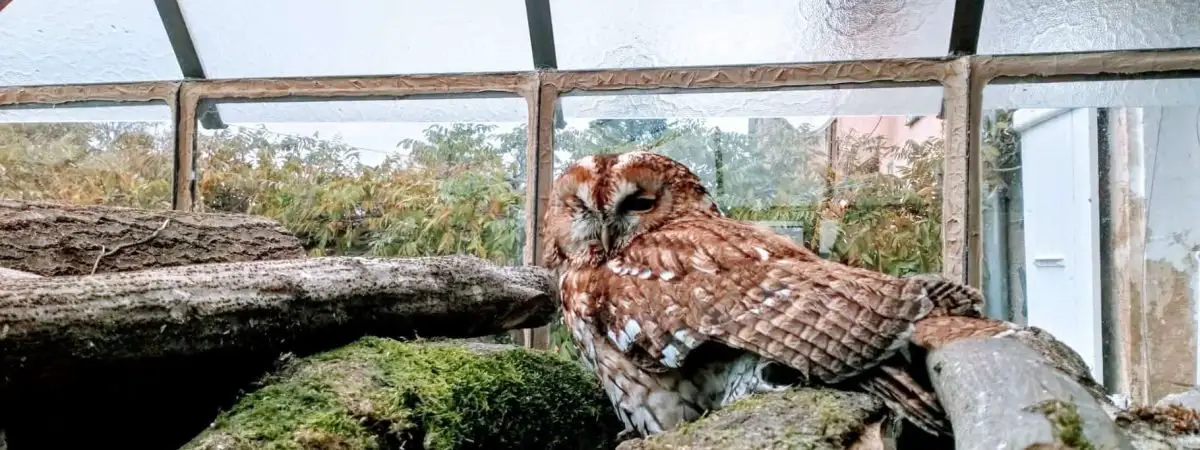
There are 15 different species of Owl that live in Oregon.
They are the:
- Barn Owl
- Burrowing Owl
- North Pygmy -Owl
- Great Horned Owl
- Western Screech Owl
- Barred Owl
- Northern Saw-whet Owl
- Short-eared Owl
- Long-eared Owl
- Flammulated Owl
- Boreal Owl
- Snowy Owl
- Great Grey Owl
- Northern Spotted Owl
- Northern Hawk Owl
Want to learn more? This National Geographic Book on Owls is a great read!
There are a variety of different habitats within the state of Oregon and these include aspen woodland, coastal dunes, estuaries, riparian habitats with flowing water, grasslands, coniferous forests, natural lakes, oak woodlands, pine woodlands wetlands and sagebrush vegetation.
The state of Oregon is home to two hundred and fifty-six state parks which are spread across 109,000 acres and incorporates a range of different habitats.
Want to attract Owls to your yard? Take a look at our article!
What Owls can be seen in Ohio?
Table of Contents
1. Barn Owl
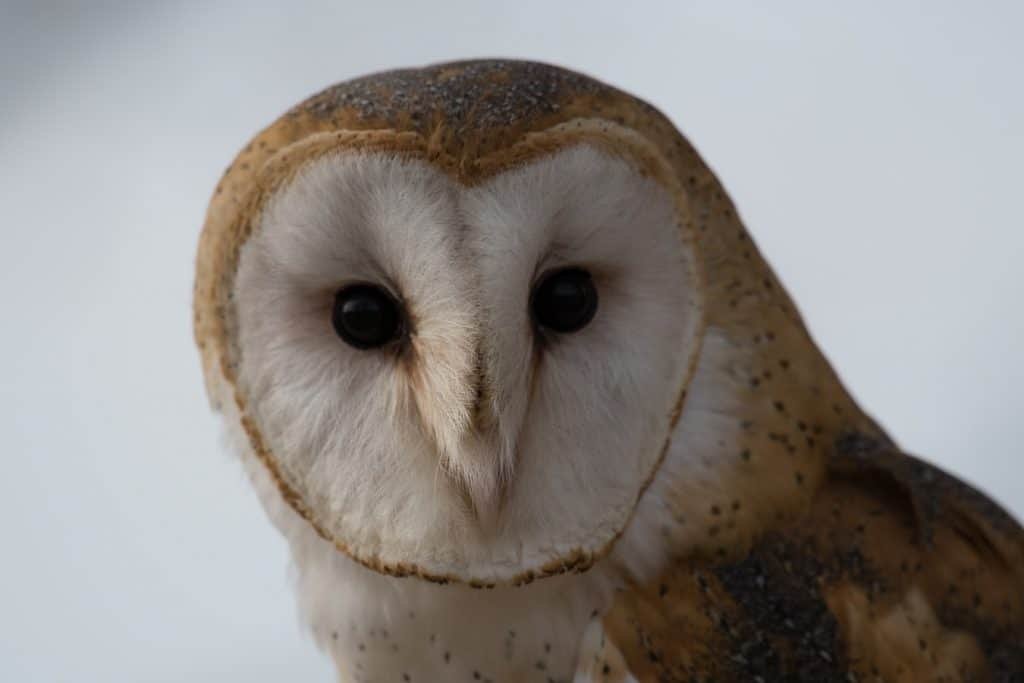
Wingspan
107 to 110 cm
Weight
430 – 620 g
Life Expectancy
Up to 4 years
Diet
Voles, Shrews & Mice
The barn owl is a common species of owl seen in Oregon and it is a pale-coloured species with a white undercarriage and an orangey coloured coat with grey spots.
It has a heart-shaped face with a white disc face. In headlights, these owls will appear very white. The barn owl is between thirty-three and thirty-nine centimetres in length and has a wingspan of between eighty and ninety-five centimetres.
To the west of the Cascades these owls can commonly be seen flying over open countryside and to the east of the Cascades they will commonly be found flying over agricultural land.
The diet of the barn owl is mainly rodents which it hunts in open areas during the night and early in the morning when they will fly low over open ground listening for small rodents.
The barn owl tends to retreat to their roosts during the day, their roosts will usually be built-in nest boxes and derelict buildings.
These are one of the more common species of owl to see as they are widespread across every continent apart from Antarctica.
2. Flammulated Owl
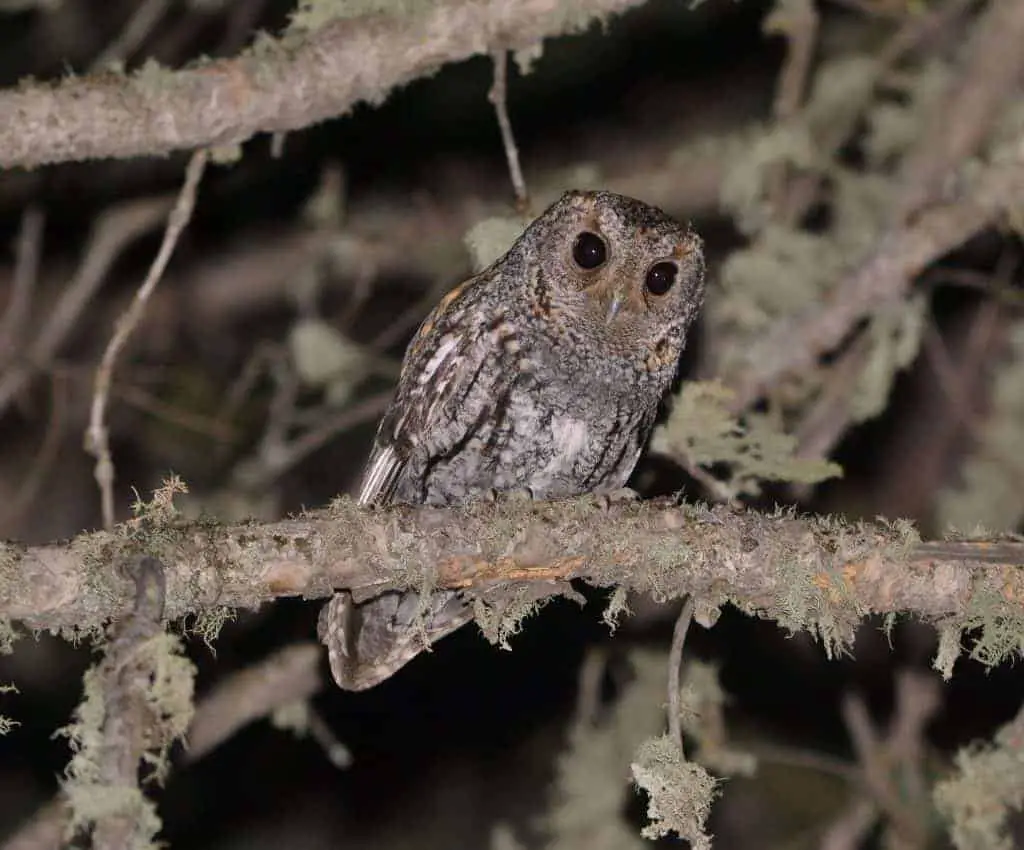
Wingspan
14inches
Weight
60g
Life Expectancy
8 years
Diet
Mostly insects
The Flammulated Owl is amongst the smallest species of owls in the area.
Their eyes are entirely dark, and their fine plumage is grey with small rust coloured bits throughout.
They tend to be about fifteen centimetres in length and have a wingspan of about thirty-six centimetres with a body mass of just under two ounces.
This species of owl tends to roost in forest areas which are dominated by pine with sparse aspen trees.
Utah is a good area to see these owls as a survey recorded forty-seven individuals within a five-mile radius.
The Flammulated owl is strictly nocturnal and they tend to feed mainly on insects. These owls migrate during the winter when they move to Mexico.
The Flammulated owls can be seen to the east of the Cascade mountains.
The Flammulated owl is featured on the conservation strategy list for East Cascades, West Cascades, Blue Mountains and Klamath Mountains.
3. Western Screech Owl
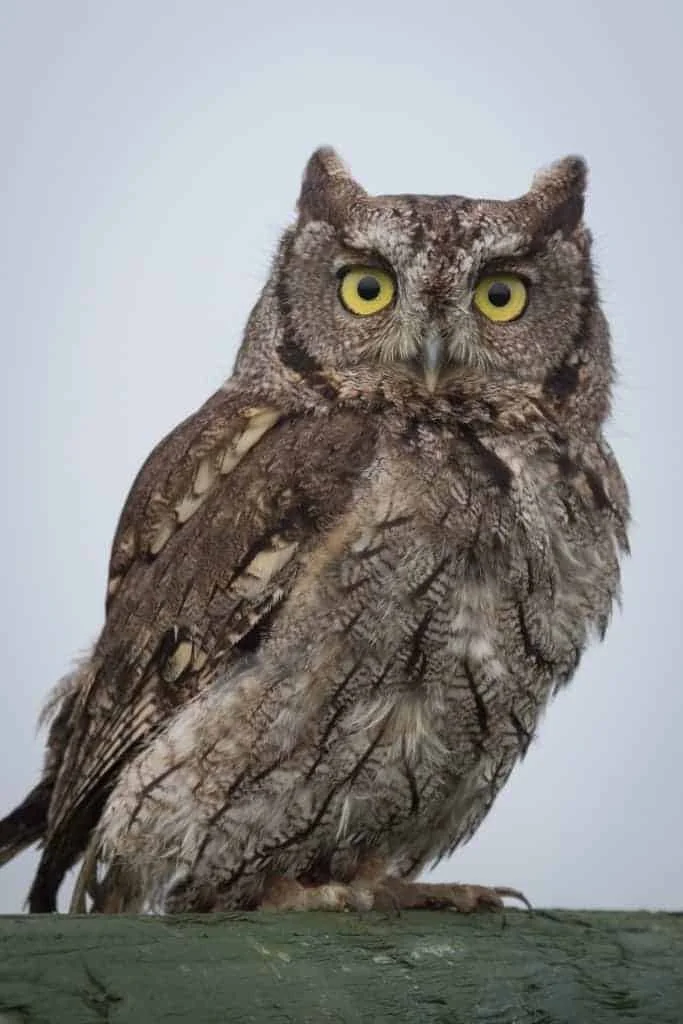
Wingspan
55cm
Weight
143g
Life Expectancy
13 years old
Diet
Insects and small mammals
The Western- Screech owl is a strictly nocturnal species and it is grey in colour and has fine streaks of white and black with short ear tufts.
These owls tend to be small with a length of between nineteen and twenty-six centimetres with a wingspan of between fifty-five and sixty-two centimetres.
The Western-Screech owls can be seen in a variety of woodland habitats especially deciduous and riparian areas especially around lower level woodland through the state of Oregon.
They can also be seen in parks and urban areas. They tend to build their nests in tree cavities or even some nest boxes, the diet for this species tends to be mainly insects, birds and small mammals.
The best state parks in Oregon for spotting the Western screech owl is Oaks Bottom Wildlife Refuge, this is a popular area for a lot of different species of birds.
The western screech owls can be seen all year round and, in the west, they are likely to be found at an elevation of about three thousand feet and around four thousand one hundred feet to the west of the Cascade mountains.
4. Great Horned Owl
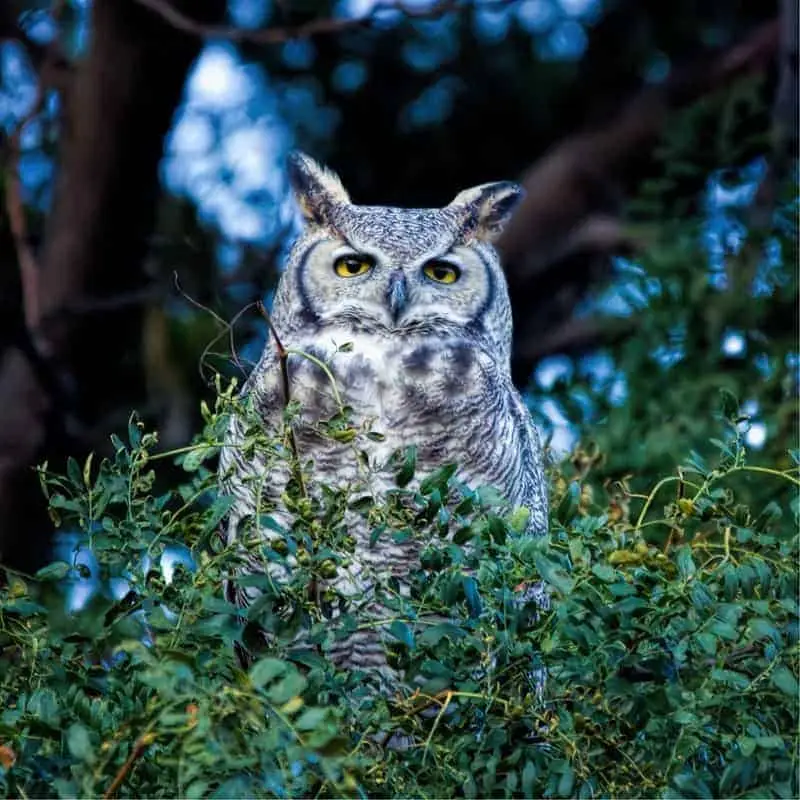
Wingspan
~140cm
Weight
1.4 kg
Life Expectancy
28 years old
Diet
Squirrels, Rabbits & Skunks
The Great Horned owl is one of the most widespread species of owl and it is one that is most likely to be spotted when looking for owls, it can be recognised by its distinctive ear tufts.
This species of owl has a stocky build and it is very powerful. These owls can be seen in a variety of habitats which includes deserts with sparse trees, prairies and dense woodland areas.
It is not uncommon for these owls to be found in suburban and towns amongst woodland.
The Great Horned owl is well camouflaged for living in woodland areas with its dark brown colour, however the shade of brown can vary amongst the species.
The Great Horned owl is between forty-six and sixty-four centimetres in length with a wingspan of between one hundred and one and one hundred and forty-five centimetres.
The diet of the Great Horned owl tends to comprise of reptiles, birds and mammals. These owls can be seen all across Oregon.
5. Northern Saw-whet Owl
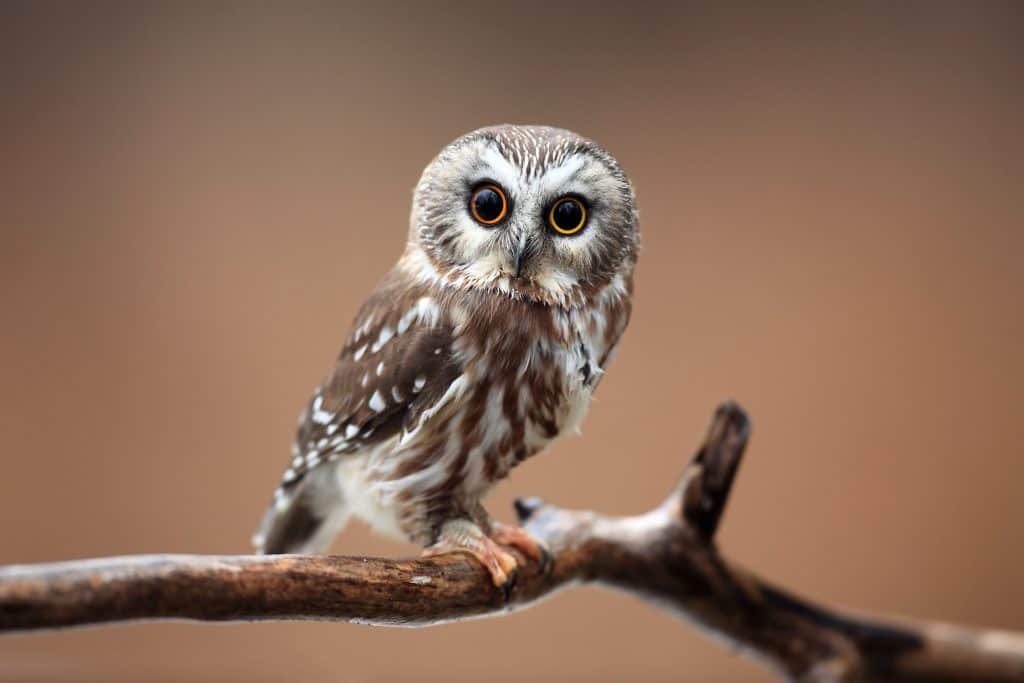
Wingspan
40 - 60 cm
Weight
100 g
Life Expectancy
7 years
Diet
Small birds, young squirrels, voles & shrews
The Northern Saw-Whet owl is one of the smallest species of owl found in the north of America and it is a native species.
These owls tend to be between eighteen and twenty-two centimeters in height. These owls can be found in woodland areas that are home to mostly conifers and they can often be found at eye level although they can be found at heights of twenty feet.
The Northern Saw-Whet owl breeds at lower elevations within a mixture of deciduous and coniferous vegetation.
The diet of the Northern Saw-whet owl consists of small rodents such as mice and voles.
They will also eat young squirrels, large insects, and small birds. They hunt mainly during the night and will spend a lot of time sitting on perches waiting for prey which it senses through both sight and sound.
One of the best state parks in Oregon for spotting the Northern Saw-whet owl is Indian Ford Campground, which is located about six miles to the northwest of the Three Sisters mountains. In the coastal areas of Oregon this is the most common species of owl that you will find.
6. Short-Eared Owl
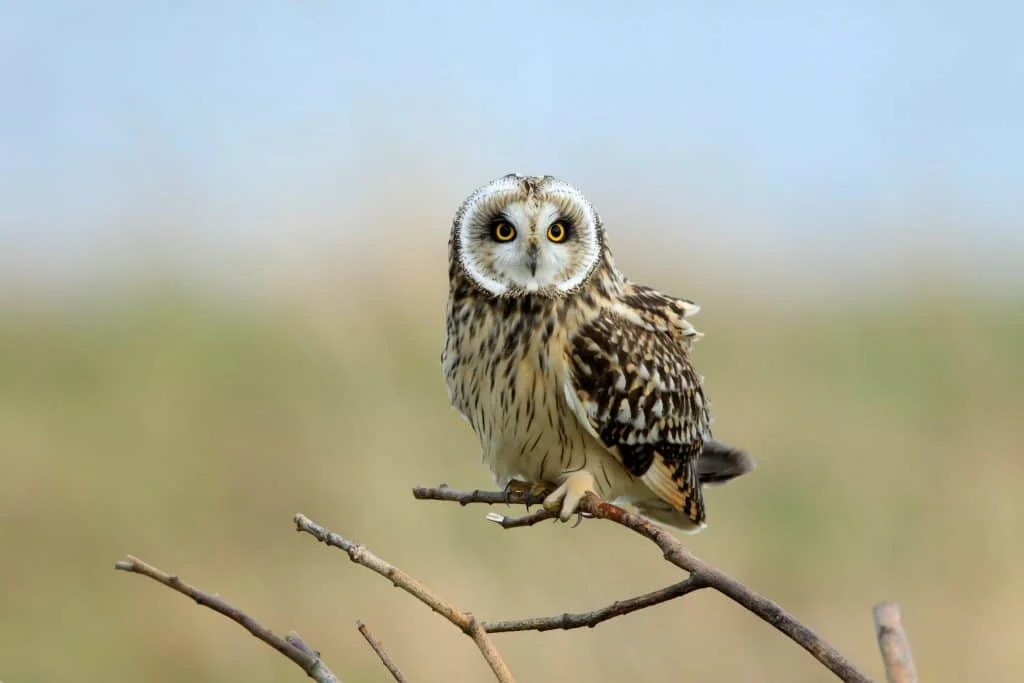
Wingspan
85 to 110 cm
Weight
206–475 g
Life Expectancy
4-12 years
Diet
Voles, Mice, Squirrels
The short-eared owl is a medium-sized owl which is commonly seen during the day and it is especially active at dusk and dawn during which time it can be seen flying around the marsh and open field areas.
These owls are pale brown in colour with a pale-coloured belly. It has spots and streaks on the wings and chest.
At the tips of their wings, they have big fluffy patches which can easily be seen when they are in flight. Female short-eared owls tend to be a darker shade on brown compared to the males.
The short-eared owl tends to be between thirty-four and forty-three centimetres in length with a wingspan of between ninety and one hundred and five centimetres.
The diet of the short-eared owl tends to consist of small mammals especially voles. The best state park for spotting the short-eared owl is the Malheur National Wildlife Refuge.
This species of owl is very common in open countryside, but its distribution varies from one year to the next. During breeding season this species can be seen around large wetland areas.
7. Snowy Owl
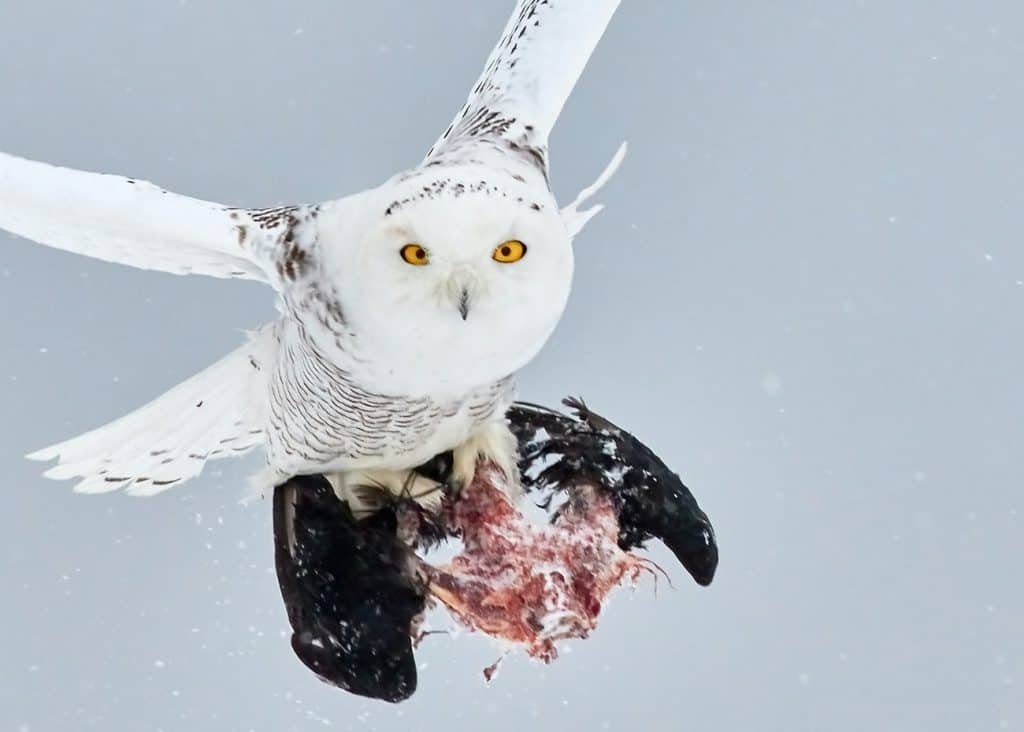
Wingspan
150 cm
Weight
2 kg
Life Expectancy
10 years
Diet
Birds, Rabbits, Fish & Rodents
The snowy owl is a lovely species of owl with its white plumage incorporating a range of black markings throughout.
This is one of the biggest owls in North America and it’s coloring makes it ideally adapted to live in arctic areas.
The male Snowy owls tend to have a whiter plumage and the juvenile females tend to have a lot of black markings throughout their plumage.
The Snowy owl has a length of between sixty-three and seventy-three centimeters and a mass of about two kilograms.
The wingspan on the Snowy owl can range from one hundred and sixteen to one hundred and eighty-three.
These owls tend to roost in areas which are close to the coast and lakeshores. During the winter months, they will reside around sand dunes and piers.
The preferred diet for the Snowy owl is lemmings, however, they will also eat fish, rodents, birds, and rabbits.
Snowy owls have a very strong ability to see and hear, which is very helpful when it comes to hunting.
8. Long Eared Owl
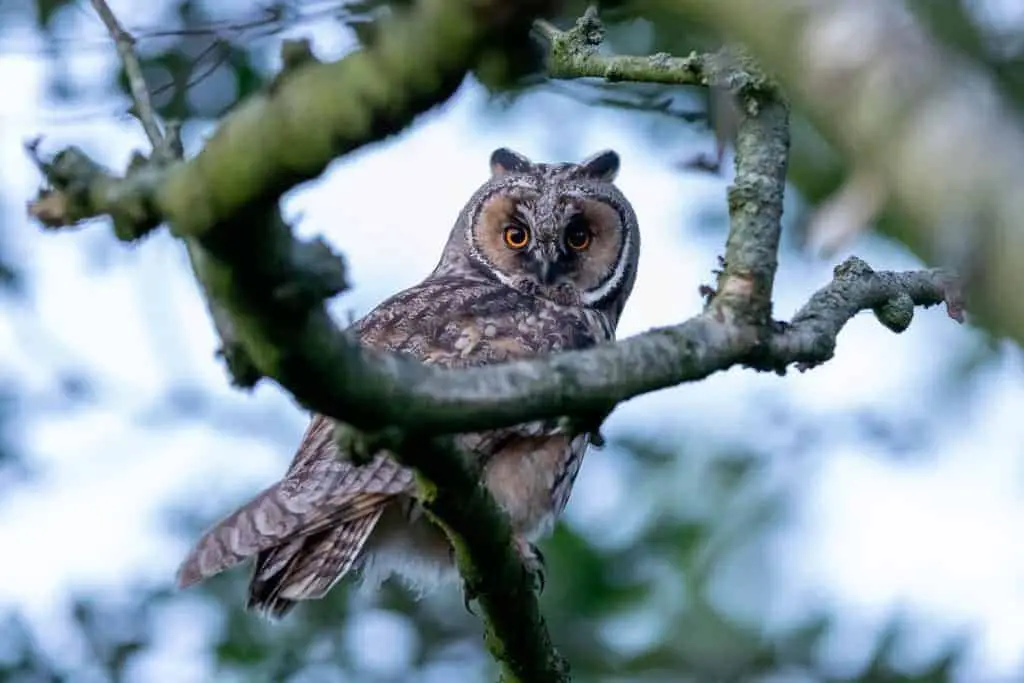
Wingspan
90 to 100cm
Weight
250 g
Life Expectancy
4 years
Diet
Small mammals, mice, rats & rabbits
The long-eared owl is a medium-sized species of owl. These owls are slender with an orange patchy face and long ear tufts.
These owls are strictly nocturnal and will be found in areas a mixture of coverings and various densities.
The long-eared owl tends to be between thirty-five and forty centimeters in length with a wingspan of between eighty-four and ninety-five centimeters.
Although they make their roosts in areas with the dense cover they much prefer to hunt in open spaces.
These owls are seldom seen and during the winter months, they will roost in groups of about twelve.
The long-eared owl is a similar size to the small-eared owl but has long ears which are darker and orange patches on the tips of their wings.
The long-eared owls can be spotted on the eastern side of the Cascade mountains. It is common for the long-eared owls to breed on Boardman Bombing Range.
The diet of the long-eared owl consists mainly of small rodents however they have been known to eat small birds, especially during the winter months.
9. Northern Hawk Owl
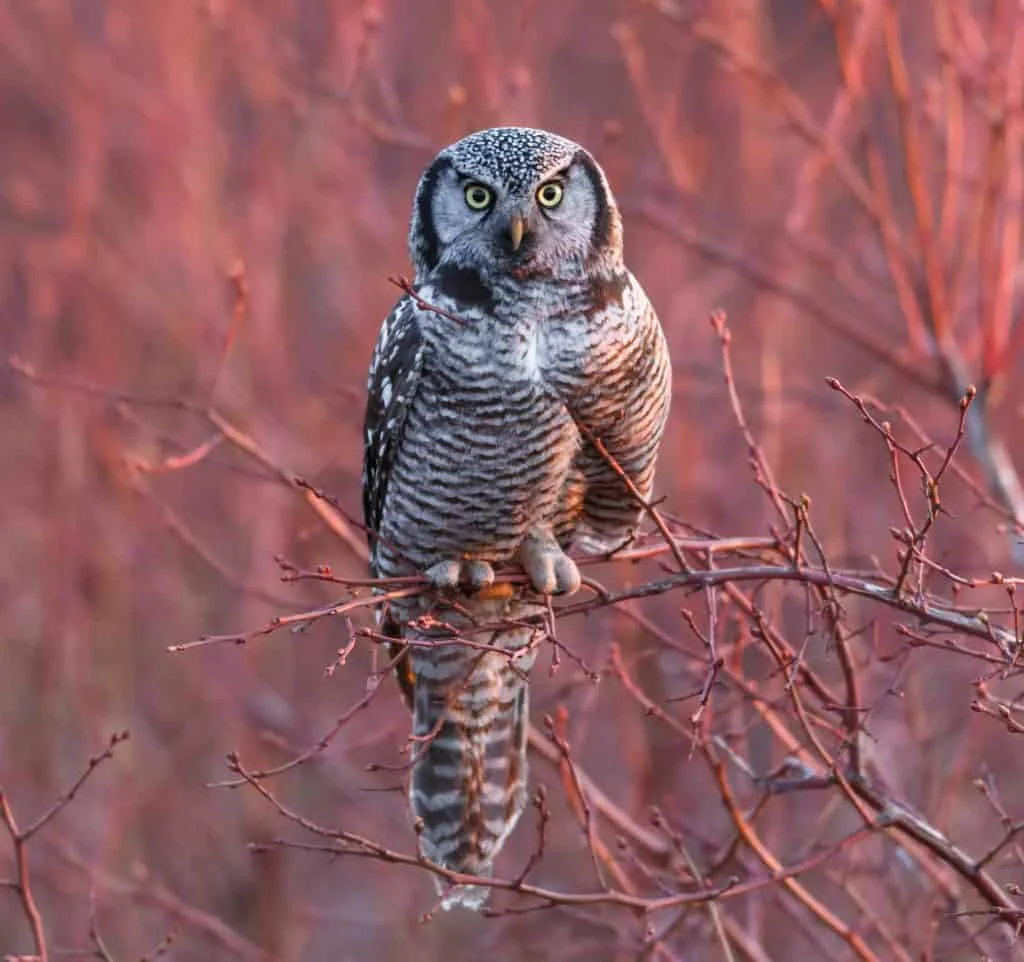
Wingspan
45 cm
Weight
300 -340 g
Life Expectancy
Up to 16 years
Diet
Rodents & Small Mammals
The Northern Hawk owl is a medium-sized owl in northern America and it has an oval-shaped body with short pointed wings and a long-pointed tail.
These owls are between thirty-six and forty-five centimeters in length with a wingspan of about seventy-one centimeters.
The Northern Hawk owl is brown with white spots and brown horizontal stripes on their undercarriage.
They have a white face that features a black border and sharp yellow eyes. This species is mainly active during the day, but it also hunts during the dark.
When hunting it will perch on prominent branches and survey for prey, then it will glide to the ground using powerful and deep wingbeats.
These owls can spot prey from half a mile away. The Northern Hawk owl lives in open or marshy forest areas that are home to mixed or coniferous vegetation.
They are often found in areas that have a sparse population of spruce trees. The diet of the Northern Hawk owl tends to be mainly voles and other small rodents and mammals.
They will also eat small birds such as jays, starlings, and robins. It is not uncommon for them to take on larger prey such as snowshoe hares.
10. Great Grey Owl
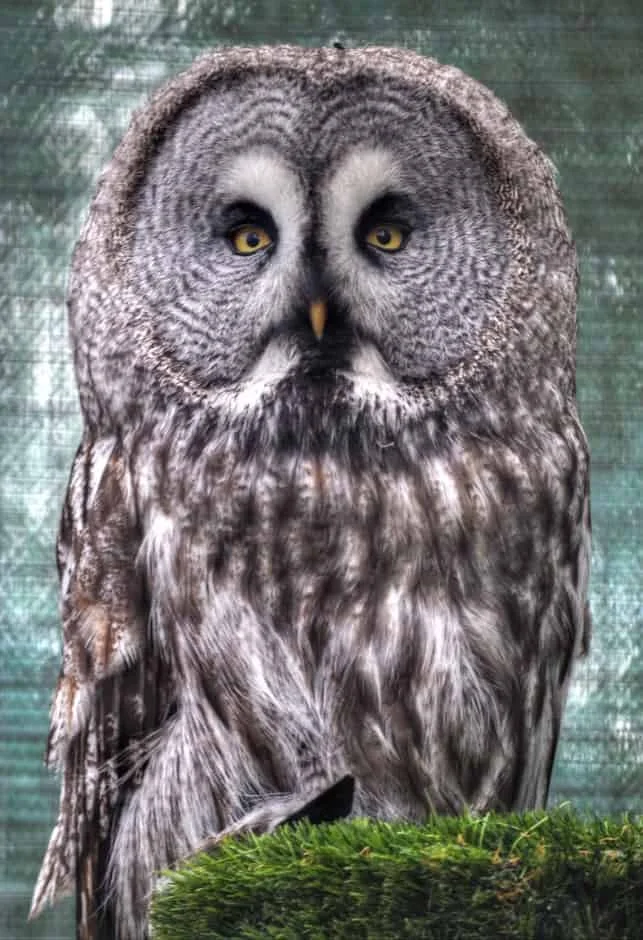
Wingspan
Up to 152cm
Weight
1.1 kg
Life Expectancy
12 years old
Diet
90% small rodents
The Great Grey Owl is a large sized owl which can be seen around meadows, bogs and in coniferous forest.
This is a rare species of owl and it hunts around dawn and dusk. The Great Grey owl tends to be between sixty-one and eighty-four centimetres in length with the females being larger than the males.
They can have a wide wingspan in excess of one hundred and fifty-two centimetres, however more commonly it is one hundred and forty-two for females and one hundred and forty for males.
When hunting this owl will perch on the edges of clearing and watch for its prey. Their diet tends to comprise mainly of voles.
The Great Grey owl can be distinguished from other species of owl with its white bow tie shaped pattern on its neck and its large yellow eyes.
The Great grey owls can be seen in the north-eastern areas of Oregon and to the south of the Siskiyou and Cascade mountains.
11. Boreal Owl
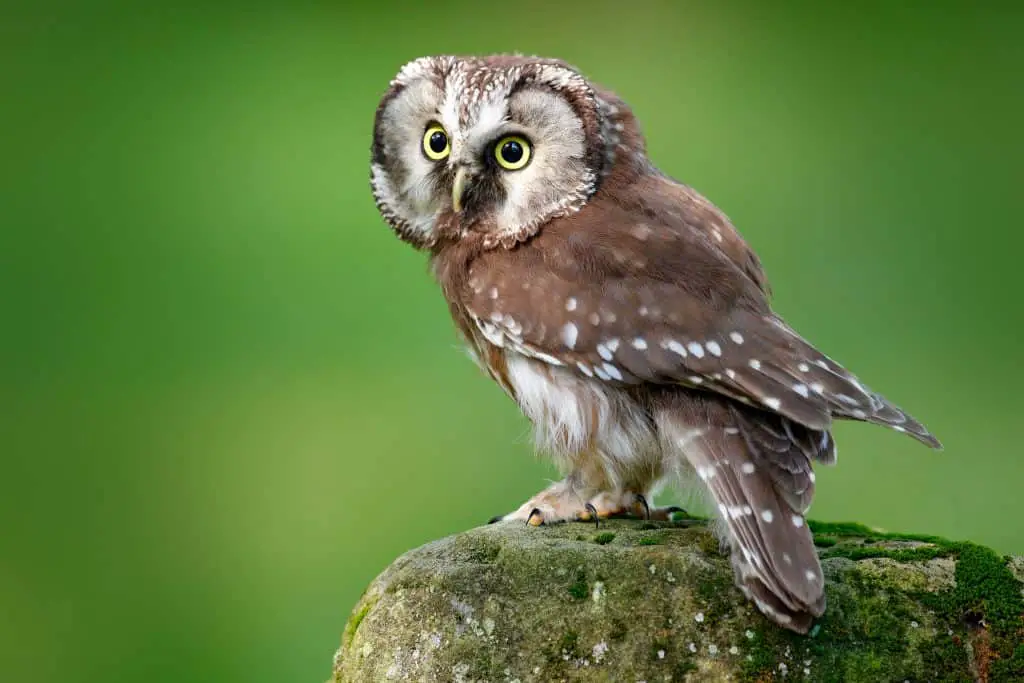
Wingspan
50–62 cm
Weight
120 g
Life Expectancy
16 years
Diet
Small mammals, birds & insects
The Boreal Owl is one of rarest owls seen in this area and they are seldom seen.
These owls are slightly bigger than the Northern Saw-whet owls. Boreal owls are small with a spotted body which makes it stands out from other species of owl.
One of the key features of these owls is the absence of ears. They tend to be between twenty-one and twenty-eight centimetres in length.
The wingspan on the Boreal owl is between fifty and sixty-two centimetres. This species is a grey-brown colour with spots on its forehead.
The diet for the Boreal owl comprises of small rodents and it is not common for them to hunt around birdfeeders.
The Boreal owl tends to make its nest in tree cavities especially varieties such as Aspen and Spruce.
This species was thought to have originally been limited to the Boreal forests of Canada, however in the 1980’s it was found breeding on the Rocky Mountains.
These are very shy owls which are strictly nocturnal.
12. Northern Pygmy Owl
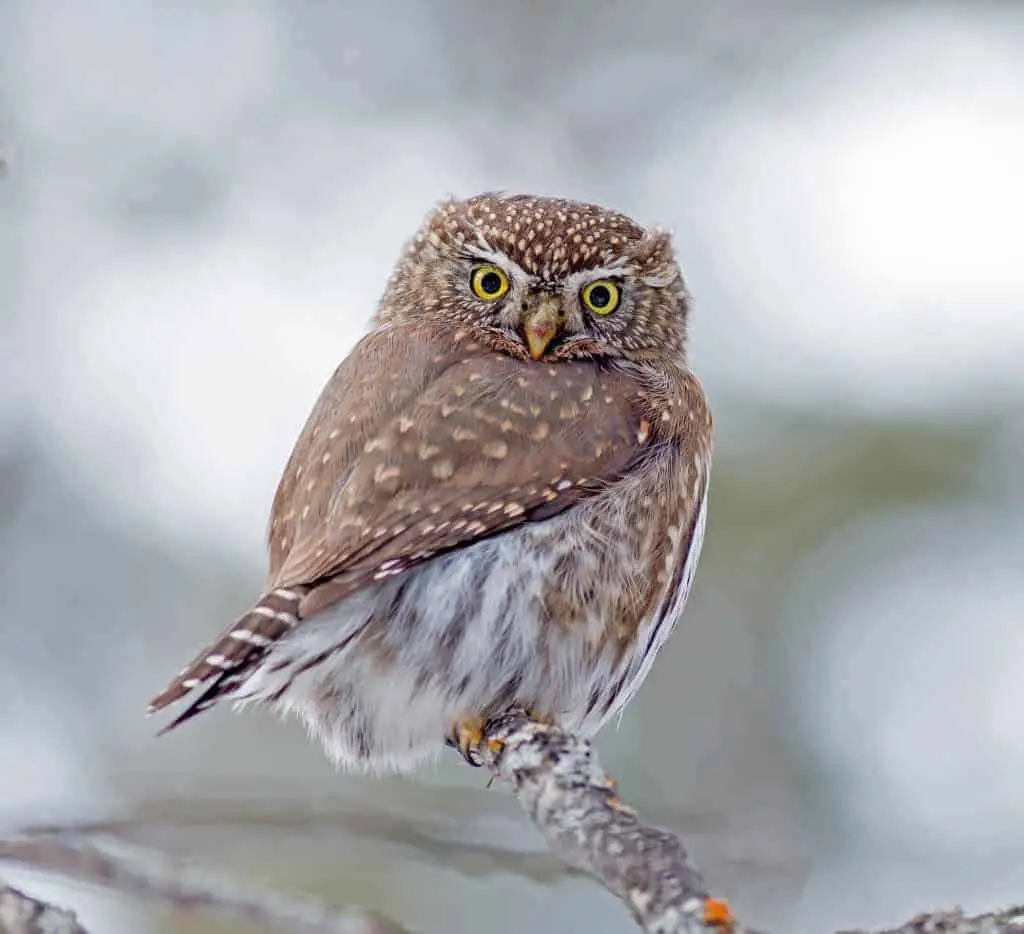
Wingspan
15 inch
Weight
2.25oz
Life Expectancy
6-7 years
Diet
Small birds
The North-Pygmy owl is a small species that tend to live in the forests of the mountainous areas of the western State of America.
These owls are brown and white in color which a yellow bill and yellow eyes. The North-Pygmy owl is a rare species that is very difficult to find, however, sometimes it perches conspicuously.
Although this is a fairly small owl is known as being a fierce predator. The north -pygmy owl is between fifteen and seventeen centimeters in length.
These owls are similar to the Northern Saw-whet owls, but they never perch out during the day. The diet of the North-Pygmy owls tends to consist of mammals and small birds.
These owls although very rare, can be seen across the forested areas of Oregon and one of the best state parks for spotting the north pygmy owl is the Indian Ford campground.
It is can be easier to spot a north-pygmy owl as they hunt during the day and tend to watch for their prey from the tops of conifer trees.
13. Burrowing Owl
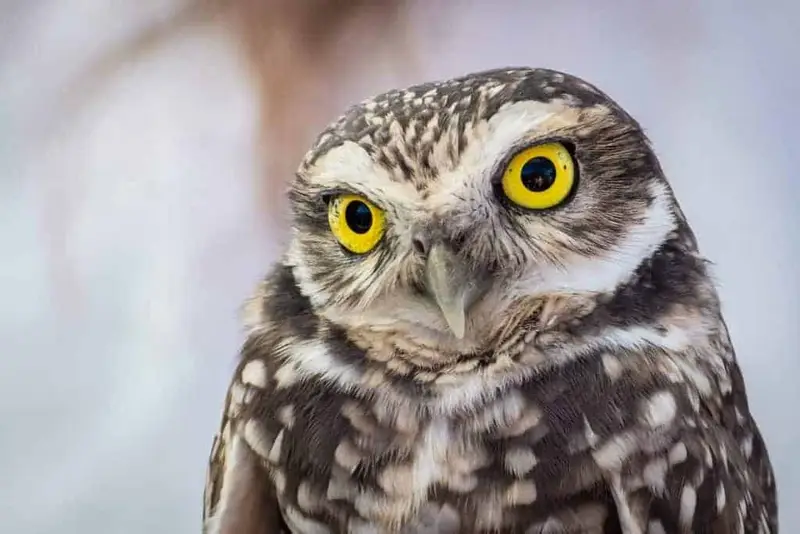
Wingspan
51-61 cm
Weight
140-240 g
Life Expectancy
10 years
Diet
Large Insects and Small Rodents
The burrowing owl has a small structure with a short tail that looks square and they have long slender legs and tend to live on open grassland.
Burrowing owls tend to be twenty-three centimeters in height and weigh between one hundred and thirteen and one hundred and eighteen grams.
Female owls tend to be slightly smaller, which is unusual amongst owl species.
From a distance, these owls look brown with an irregular pattern of white spots and they have yellow eyes. Juvenile burrowing owls do not have as many spots as the adult owls.
Burrowing owls natively live in desert and grasslands in the north western area of the United States. They tend to spend winters in the southwest.
The burrowing owl is commonly seen perching on rocks or low fence posts and sometimes even on the ground.
These owls can be seen during the day and night when they will be foraging for small mammals and insects. Most of their diet is made up of reptiles, rodents, small birds, large insects, and fish.
They can be seen hovering above the ground searching for prey or hunting from a low perch. It is not uncommon for them to catch insects on the wing.
One of the best state parks for spotting the burrowing owl is Malheur National Wildlife Refuge which is located in the northwest of the state.
14. Barred Owl
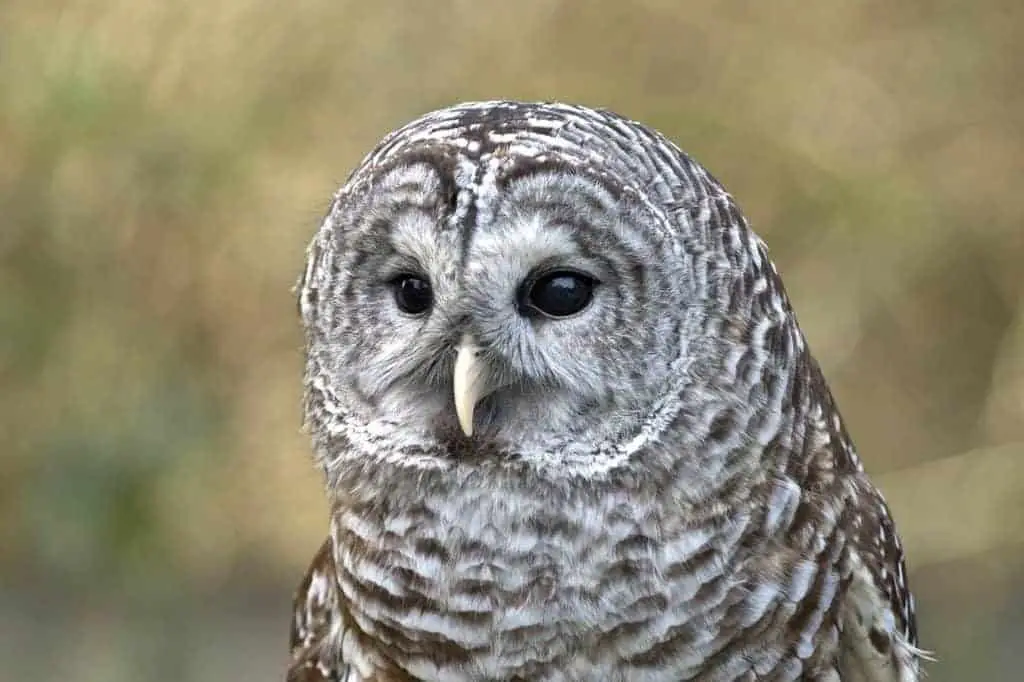
Wingspan
96-125 cm
Weight
468-1,150 g
Life Expectancy
10-23 years
Diet
Small mammals
The Barred Owl is one of the larger owl species and it is mottled brown and white in colour.
These owls have a rounded head with black eyes and a lack of ear tufts. Barred Owls tend to live in large forest areas with mature coniferous and deciduous trees and they tend to live near water.
The barred owl is between forty-eight and fifty centimetres in length with a wingspan of between ninety-nine and one hundred and ten centimetres.
These owls tend to hunt small animals during the night however they are also active during the day.
During the day these owls will doze on high perches and will fly off at the slightest disturbance.
Barred owls tend to hunt from a perch however they will also catch on the wing. Their diet tends to consist of amphibians, reptiles, invertebrates, birds and mammals.
The barred owl can be seen in the northeast and western areas of Oregon. The barred owl was first recorded in Oregon during the early part of the 1970’s and since then it has spread into forest areas all across the state.
15. Northern Spotted Owl
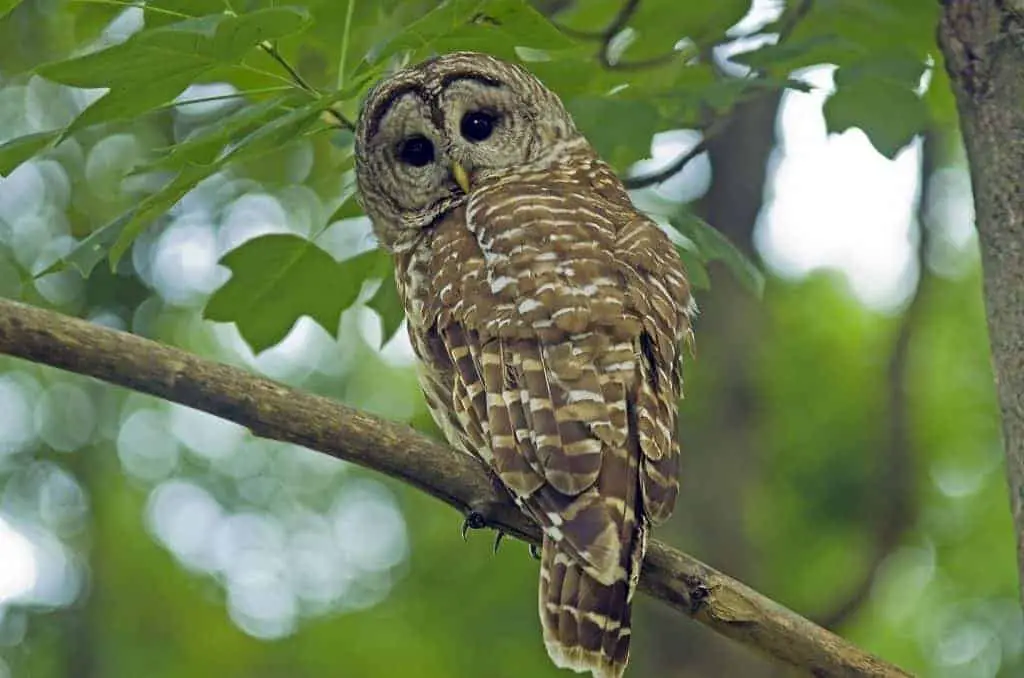
Wingspan
114cm
Weight
600g
Life Expectancy
16-21 years
Diet
Small mammals
The Spotted owl is a medium-sized species of owl that tends to be found in mountainous areas with a good population of oaks and conifers.
The Spotted owl has brown plumage with large white spots on its back and belly. The Spotted owl also has large black eyes which are uncommon amongst owls.
These owls tend to be about forty-three centimeters in length with a wingspan of one hundred and fourteen centimeters.
There are two distinct populations of the Spotted owl, one which lives along the Pacific coast and the other lives in the Sierra Nevada.
The birds that live in the south tend to have a richer brown plumage.
The preferred diet for the Northern Spotted owl consists mainly of small rodents but they have also been known to eat invertebrates, birds, and reptiles.
One important fact about these owls is that they are an indicator species which means that where they are found there is a good ecosystem, which is useful when they tend to be found in older woodlands.

More Articles.
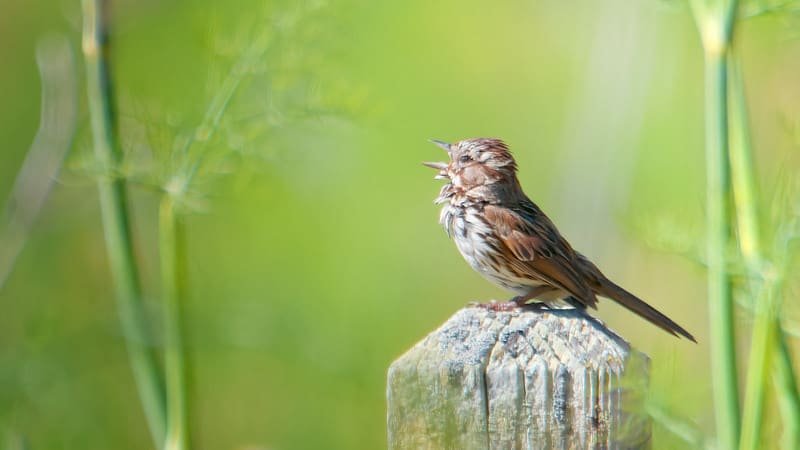
Why do Birds Chirp at Night? (5 Birds with Pictures and Sounds)
A bird singing and chirping can be heard at all times of the day. Most
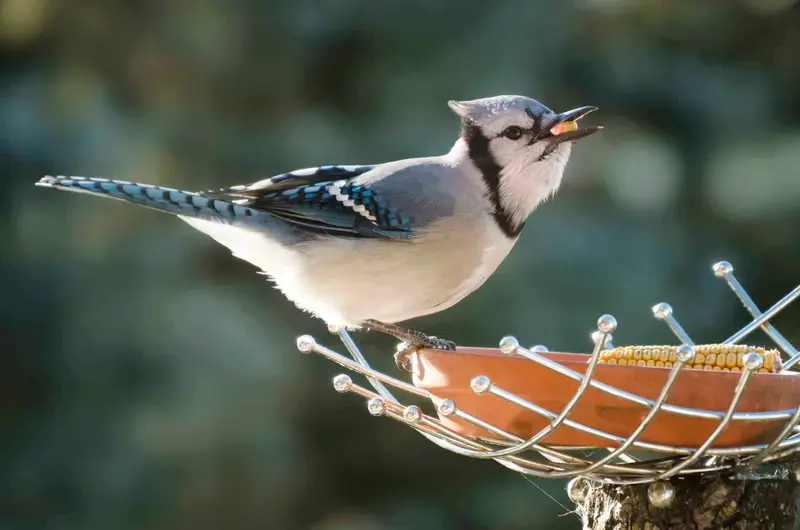
How to Attract Blue Jays to your Yard?
Some may vehemently argue that Blue Jays are the bullies of the bird kingdom and
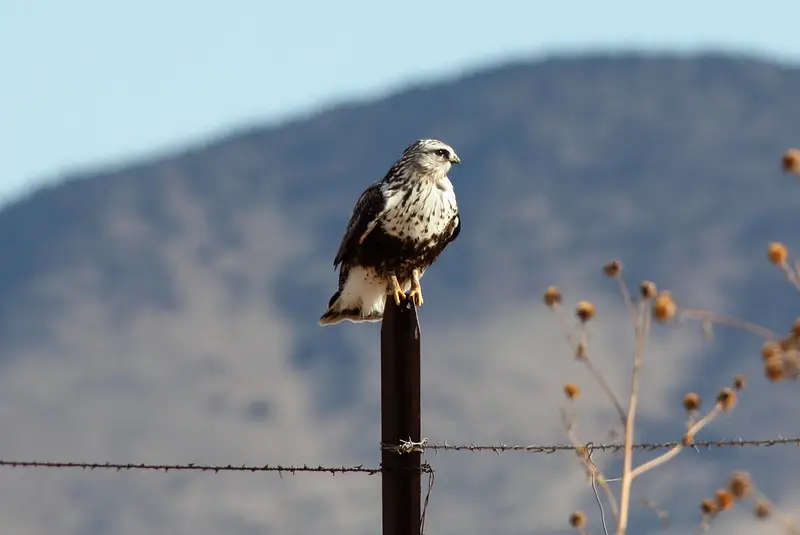
What Hawks can you see in the Netherlands? (3 Species with Pictures & Sounds)
What Hawks can you see in Netherlands? There are 3 different species of Hawks that

About Us
We are avid bird-watchers who recently retired, allowing us more time to travel the world. Fortunately, we have managed to visit numerous countries around Europe, Asia, and America. Watching and photographing birds has been a passion for many years and we are making the most of the extra time on our hands!
